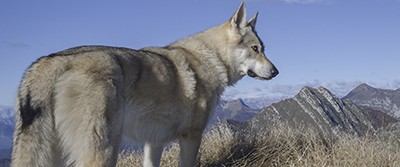Himalayan Wolves Could Be a Unique, High-Altitude Species

By Mike Howie
The wolves of the Himalayas live at elevations where many other creatures, including humans, would struggle to breathe. Their vast and sometimes inaccessible territory ranges throughout the mountains of China, Mongolia, and Kyrgyzstan — upwards of 13,000 feet above sea level.
At this height, the air contains less than 50 percent of the oxygen found at sea level. But Himalayan wolves thrive in a way that nearby grey wolves living at lower elevations probably couldn’t. Scientists now believe that they are actually a subspecies of grey wolf, if not an altogether unique species.
Genetic Adaptation
In a study led by the University of Oxford’s Dr. Geraldine Werhahn and published in the Journal of Biogeography, scientists explained genetic adaptations that help Himalayan wolves live a high-elevation lifestyle that sets them apart from other wolves. Using fecal samples, they extracted DNA that represents 86 wolves and found specialized genes that help the animals overcome a lack of oxygen. Some of them help strengthen the heart and deliver more oxygen through the blood.
The traits are similar to those that make Tibetan people so suited for life at high elevations. Researchers have long wondered how they live and breathe so easily at elevations above 14,000 feet. They initially thought Tibetans might have more oxygen-rich hemoglobin in their blood, just like other people who have made their homes high in the mountains. However, further research found that they had less hemoglobin.
Then, in a 2010 study, researchers found gene variations in many Tibetans that help them use oxygen more efficiently. It’s believed that the Tibetan people inherited these genes by interbreeding with Denisovans, archaic and now extinct humans who lived upwards of 30,000 years ago.
Similarly, Tibetan dogs also inherited genes that help them thrive at high altitudes through interbreeding — with Himalayan wolves.
Evolutionary Significance
Werhahn’s study shows just how genetically unique Himalayan wolves are, and it will help formally classify the wolves as a subspecies, complete with a scientific name. With that in place, Himalayan wolves will be given a conservation status by the International Union for Conservation of Nature.
While the scientists are unsure how many Himalayan wolves are in the wild, the study suggests that they live in a wider geographic range than initially thought. The widespread presence of their scat suggests that they roam the entire Tibetan plateau, not just the Himalayas. Classifying the wolves as a subspecies is the first step toward protection.
Werhahn is still working to show that the wolves are their own species. “Everything is pointing towards it being eligible for full species status,” she said, “but we need to obtain high quality genetic samples.”
Discussion Questions
- What other animals are uniquely suited for life at high altitudes?
- What other beneficial traits could Tibetan dogs have inherited from Himalayan wolves?
- Research the Denisovans. Where did they live and what set them apart from other early humans?
Vocabulary
- Genetic Variation
- Hemoglobin
- Interbreed

